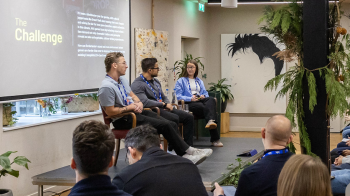Future Trends Volume 13: The Future of Money
Future Trends Working Group
The IAB’s Future Trends Working Group aims to shine a light on the path ahead for the digital advertising industry by looking at different topics each quarter and thinking about what they might mean for the advertising industry.
Previous topics have included the Internet of Things, Future Threats and Wearable Technology.
This quarter we looked at the launch of Apple Pay and as well as trying to answer the question of whether Apple Pay means the end of money, Dan Calladine and Chris Buckley looked at what Apple Pay means for apps.
The end of the coin as we know it? What does Apple Pay mean for the future of money?
Tim Elkington, IAB UK “Paying by touching with a phone is easier than paying by tapping a card, which in turn is easier than paying with a card and a pin code, which in turn is easier than paying with cash. However, cash still has some advantages, for example it doesn’t need charging and can be used anywhere, regardless of connectivity or signal strength. So while convenient, Apple Pay doesn’t mean the end of cash.”
Chris Buckley TMW “It’s not the end of money, but cash won’t be the only thing in our pocket that can we can use to pay for the small and perhaps bigger things in life.”
Dan Calladine, DentsuAegis “Apple pay doesn’t mean the end of money, but it – and other mobile payment methods – will mean that we carry less money around, as we have progressively since the introduction of ATM cards.”
Kate Osborne, ARC (an Omnicom Media Group company) “Apple Pay in itself doesn’t mean the end of money but the rate of its adoption will undoubtedly be a contributing factor for governments as they start looking at passing legislation encouraging consumers and businesses to dump notes and coins and go electronic as they have been doing in Denmark and the Philippines.”
Apple Pay – What it means for Apps
Chris Buckley, TMW
We’re already fairly comfortable with the concept of frictionless online payments - how many of us enter a credit card when we buy from amazon or download an app?
What Apple have done for electronic payment is what they’ve always done. They take an existing technology or paradigm, and wrap it up in a shiny, well designed box and apply a user experience that means your grandmother can use it. Apple acts as the trojan horse that gets the kind of mainstream acceptance that purely technology led, albeit useful, products cannot achieve alone.
This isn’t sour grapes - Apple provide an essential service here. They filter out the frivolous and refine the products with genuine utility until none of us can conceive of a time when we didn’t have access to them.
What does this mean for the consumer and the retailer? Ease, utility and inevitably another step away from the physical, untidy world of cards and coins.
There will be a massive halo benefit to the other more established platforms (like Paypal for example who, as of Q1 2015, already have 165million active users - Uber and Ocado for example are already fully integrated with the platform). Platforms like Paypal and Google Wallet will now engage in an arms race with Apple to produce the most intuitive and accepted payment systems that can integrate with phones and wearables.
Dan Calladine, DentsuAegis
Apple Pay will also be available integrated within lots of apps. This means that when you want to pay for something you no longer need to enter card payment or delivery details – they’re already there. It’s also as secure as it can realistically be, as with the in-store payment – through fingerprint recognition.
Apps that will use Apple Pay at launch include Addison Lee, Airbnb, British Airways, Ocado, Top Shop, thetrainline, YPlan (events app), and Zara.
I have a feeling that this may make a bigger impact than in-store payments, because, as with the simplicity of signing into an app with your Facebook ID, the integration of Apple Pay means that you’re ready to use the app within seconds of downloading it. If you had the choice of buying from a merchant that used Apple Pay & one that didn’t, you’d always go for the easier option, other things being roughly equal.
It will make the experience of buying through the apps that integrate – and this is likely to grow over time – as easy as it is to buy with the Amazon mobile app – so easy that you can do it in a few taps, rather than putting in your payment details ever time.
Written by
Future Trends Working Group
Topics
Related content
Debrief 2025: How brands are redefining connection, creativity and commerce
Learn moreDFS follows its “What’s Your Thing?” mantra into the spotlight with October’s Joy of Digital Award
Learn moreIAB UK manifesto for growth in digital advertising
Learn moreMood, mindset and meaning: how audio and culture shaped day two of IAB Upfronts
Learn more
Fast forward to 2030 with Futurescape
An in-depth exploration of the attitudes, innovations and media shifts that will shape the years ahead and redefine how we advertise by the turn of the decade



